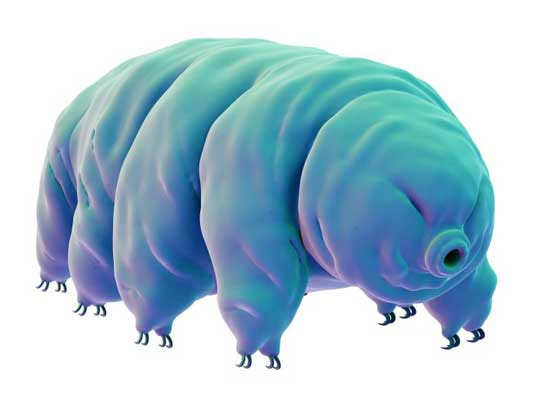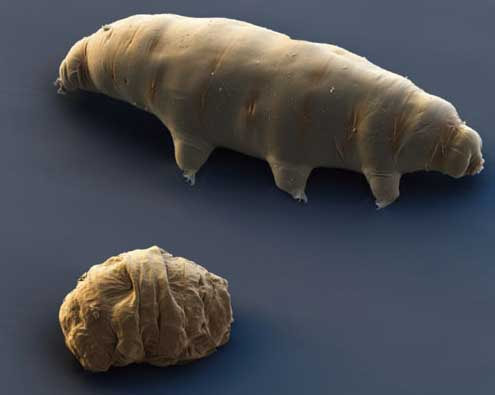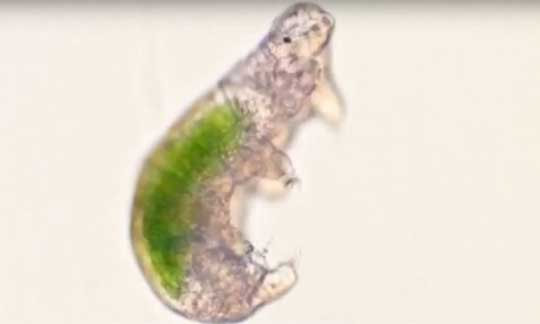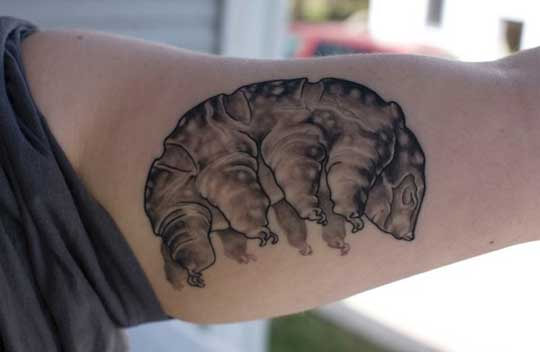|
I want to thank reader James Frederick for suggesting that I feature this creature. The Water Bear is also known as the Tardigrade. And another common name for it (which is actually my favorite) is Moss Piglet. Let's find out why it is such an awesome animal. What the heck is a Water Bear? The first thing I should say is that water bears (Tardigrades) are small. In most of the species, the adults are only 1 to 1.5 millimeters long. Not quite microscopic, but pretty darn close. Tardigrades are in their very own phylum. A phylum is the next category beneath a kingdom... so a phylum is a really significant group. For example, the phylum Chordata includes all animals that have a dorsal nerve cord (spinal cord), including all vertebrate animals. There are only about 1,100 species of tardigrades in the phylum. Tardigrades typically have eight legs, they live in water, and they can be found, quite literally, everywhere on Earth. I'm not kidding about this. They live on mountaintops, at the deepest parts of the oceans, in deserts, in rainforests, in Antarctica, even in volcanoes and deep sea vents. They are one of the most resilient animals known. Amazing facts about Water Bears You may think I'm exaggerating about tardigrades living everywhere, but I'm not. Many species of tardigrades live (and feed) on moss, but others live pretty much anywhere that a thin film or water or tiny drops of water can exist, such as in sand dunes and sand beaches. About 150 species live in oceans, some of them at depths of almost 5,000 meters. They have been found in freshwater lakes that are 150 meters deep. They are abundant in soil and leaf litter. And they have been found at higher than 6,000 feet in the Himalaya Mountains. Did I mention that tardigrades have superpowers? Well, buckle up, because we're going to explore these amazing abilities. But first, I'll explain that most of these abilities are possible due to the creature's knack for cryptobiosis... a general term that describes several forms of suspended animation. When conditions become harsh, a tardigrade will expel almost all water from its cells, nearly stopping all metabolic activity. It becomes what one scientist described as an "indestructible pellet." This pellet is called a tun. In 2007, scientists sent tardigrade tuns into space, in which the tardigrades were exposed to the heat, solar radiation, and vacuum of space for 12 days. Afterwards, when they were rehydrated, they became active, and they grew, ate, and even reproduced. Tardigrades are the only multi-cellular animal we know of that can survive these amazingly harsh conditions. Tardigrades can turn into glass. When their environment becomes extremely dry, tardigrades become tuns and produce a special kind of "bioglass," which holds the proteins and other molecules together until the creature is rehydrated. When things get wet again, the glass dissolves, and the tardigrade comes back to life. In 2014, scientists pulled out some tardigrades that had ben placed in a freezer back in 1983. After being frozen for over 30 years at -4 degrees F (-20 C), three of the creatures came back to life. One of them started laying eggs six weeks after defrosting. But that's not really cold at all to a tardigrade. These creatures have been frozen for 26 hours at -423 degrees F (-253 C) and they lived. And... the temperature of -459.67 F (-273.15 C) is called absolute zero. This is where all molecular motion stops completely. Well, in 1950, tardigrades were frozen to -459.4 degrees F (-273 C) and they came back to life afterwards. That's almost absolute zero! Here is a video of a tardigrade shriveling up and then coming back to life. Below is one of the tardigrades that was revived after being frozen for 30 years: Boiling water doesn't kill them either. Water boils at 212 degrees F (100 C). But tardigrades survive temperatures of 304 degrees F (151 C). In extreme heat, tardigrades produce specialized heat-shock proteins, which prevent the other proteins from being destroyed. The second most heat tolerant organism we know of is a bacteria that can survive at 252 degrees F (122 C). Not even close! As if that weren't enough, tardigrades can survive pressures up to 87,022 pounds per square inch! This is six times the pressure in the deepest part of the ocean. Okay, one more superpower. Um, well, kind of. It wasn't until 2016 that scientists carefully studied the life cycle of tardigrades. They observed the mating process, which consistently lasts for an entire hour. So... I guess we can add that to the list of talents. For whatever reason, tardigrades are adored by many people. More so than any other tiny invertebrate animal that I know of. Is it because tardigrades are kind of cute? Is it because they are the toughest animals on Earth? Who knows, but the following photos provide evidence of their appeal: So, the Water Bear deserves a place in the H.Z.C.A.H.O.F. (Hairy Zero Cool Animal Hall of Fame). FUN FACT: According to the Urban Dictionary, hairy zero cool means doubly awesome. Why? Well, because in slang, 'hairy' can mean awesome (um... okay, if they say so). And 'zero cool' also means awesome (it is an American slang phrase). This use of zero cool may have originated from the movie, Hackers, in which Zero Cool was the nickname of one of the hackers. Zero Cool is also the title of an early Michael Crichton novel, published in 1969. Regardless of its origin, hairy zero cool is a way to say doubly awesome! Photo Credits:
Tardigrade #1 (blue-green) - Yahoo News Tardigrade and Tun - American Scientist Tardigrade that had been frozen for 30 years - Megumu Tsujimoto, Satoshi Imur, Hiroshi Kanda/National Institute of Polar Research/SOKENDAI, Tokyo, Japan - via Popular Mechanics Tardigrade Tattoo - Discover Magazine Tardigrade Keychain - GiantMicrobes.com Tardigrade Necklace - Etsy
0 Comments
Leave a Reply. |
Stan's Cogitations
Everyone needs a creative outlet. That's why I write. Archives
April 2024
|







 RSS Feed
RSS Feed